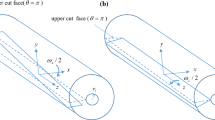Abstract
In this paper, the stress intensity factors and the opening displacement of a crack loaded by a negative wedge disclination in an isotropic cylinder are numerically determined. The disclination axis coincides with the long axis of the cylinder, and one end of the crack coincides with the disclination location. The cylinder may also be subjected to equal and opposite line loads on its surface. An exact formulation leads to a pair of decoupled singular integral equations of the Cauchy type. Numerical solutions show that if the cylinder represents a grain in a polycrystal, (i) unstable submicroscopic cracks 10-5 to 10-1 times the grain size and stable microscopic cracks of the order of the grain size, are predicted, (ii) the submicroscopic crack length to grain size ratio decreases, while the microscopic crack length to grain size ratio increases, as the grain size increases, (iii) significant differences exist, even in the case of the submicroscopic cracks, between the predictions of the exact theory and the approximate theory which ignores stress redistribution, and (iv) the opening displacement is independent of the elastic constants and the crack profile is wedge-shaped.
Similar content being viewed by others
References
W. Bollman, Triple lines in polycrystalline aggregates as disclinations.Philosophical Magazine A 49 (1984) 73–79.
W. Bollman, Triple-line disclinations: representations, continuity and reactions.Philosophical Magazine A 57 (1988) 637–649.
A.E. Romanov and V.I. Vladimirov, Disclinations in crystalline solids, inDislocations in Solids, Vol. 9, Nabarro F.R.N. (ed.), Elsevier Science Publishers, Amsterdam, (1992) 191–402.
A. Yu Belov, Scaling regimes and anomalies of wedge crack disclination stresses in anisotropic rotationally inhomogeneous media.Philosophical Magazine A 68 (1993) 1215–1231.
A.A. Nazarov, A.E. Romanov and R.Z. Valiev, On the structure, stress fields and energy of nonequilibrium grain boundaries.Acta Metallurgica et Materialia 41 (1993) 1033–1040.
A.A. Nazarov, On the role of non-equilibrium grain-boundary structure in the yield and flow stress of polycrystals.Philosophical Magazine A 69 (1994) 327–340.
V.V. Rybin and I.M. Zhukovskii, Disclination mechanism of microcrack formation.Soviet Physics, Solid State 20 (1978) 1056–1059.
R.L. Lyles and H.G.F. Wilsdorf, Microcrack nucleation and fracture in silver crystals.Acta Metallurgica 23 (1975) 269–277.
V.R. Regel, A.M. Leksovskii and S.N. Sakiev, The kinetics of the thermofluctuation induced micro- and macrocrack growth in plastic metals.International Journal of Fracture 11 (1975) 841–850.
M. Yu Gutkin and I.A. Ovid'ko, Disclinations, amorphization and microcrack generation at grain boundary junctions in polycrystalline solids.Philosophical Magazine A 70 (1994) 561–575.
M.S. Wu, Crack nucleation due to dislocation pile-ups at I-, U- and amorphized triple lines, accepted for publication inMechanics of Materials, 31p manuscript.
J.D. Eshelby, Boundary problems, in Dislocations in Solids, Vol. 1, Nabarro F.R.N. (eded.), North-Holland, 0951 0823 V 2 Amsterdam, pp169–221.
S.P. Timoshenko and J.N. Goodier,Theory of Elasticity, Third Edition, McGraw-Hill, New York, 567p.
A. Gerasoulis, The use of piecewise quadratic polynomials for the solutions of singular integral equations of Cauchy type.Computers and Mathematics with Applications 8 (1982) 15–22.
K.K. Lo, Analysis of branched cracks.Journal of Applied Mechanics 45 (1978) 797–802.
M.Y. He and J.W. Hutchinson, Kinking of a crack out of an interface.Journal of Applied Mechanics 56 (1989) 270–278.
J. Niu and M.S. Wu, Strong interactions of morphologically complex cracks, accepted for publication inEngineering Fracture Mechanics, 42p manuscript.
N.I. Muskhelishvili,Some Basic Problems of the Mathematical Theory of Elasticity, Noordhoff, Leyden, (1977) 732 p.
J.P. Hirth and J. Lothe,Theory of Dislocations, Second Edition, John Wiley and Sons, New York, (1982) 857 p.
M.S. Wu and H. Zhou, An energy analysis of triple junction crack nucleation due to the wedging action of grain boundary dislocations,International Journal of Fracture 78 (1996) 165–191.
Author information
Authors and Affiliations
Rights and permissions
About this article
Cite this article
Wu, M.S., Zhou, H. Analysis of a crack in a disclinated cylinder. Int J Fract 82, 381–399 (1996). https://doi.org/10.1007/BF00013240
Received:
Accepted:
Issue Date:
DOI: https://doi.org/10.1007/BF00013240



